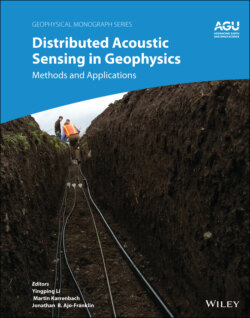Читать книгу Distributed Acoustic Sensing in Geophysics - Группа авторов - Страница 26
1.2.3. DAS Field Data Examples
ОглавлениеDAS seismic services were introduced to deliver better characterization of geophysical properties by dramatically increasing the spatial density of acquired data. DAS technology enables the collection of seismic data with a wide range of source types. For in‐well measurements, the optical fibers are embedded within ruggedized downhole cables that can be conveyed loosely in the well (wireline), or clamped to tubing and/or cemented with the completion, thereby offering a permanent sensor array (Figure 1.17). The usual assumption is that the stretching of the optical cable coincides with the deformation of the ground in the acoustic wave. In turn, the length of the optical fiber tracks the length of the optical cable due to internal friction. When the cable is attached to a pipe, the pipe deformation coincides with the ground deformation. If the cable is poorly connected to the pipe between the clamps, then lines on the VSP has a staircase‐like shape. The period of the steps equals the distance between the clamps, which is about 10 m. Fortunately, this value does not significantly exceed the DAS resolution and practically does not degrade the quality of the VSP pattern.
A typical VSP seismic shot response for permanently installed fiber optic cable behind the casing is shown in Figure 1.18 for both the raw acoustic data and with the denoising algorithm applied.
An important practical question is the ability of the DAS to perform measurements on both single‐mode (SM) and multi‐mode (MM) optical fiber, since MM fiber has been deployed in many legacy installations. It was found experimentally that seismic data can be recorded equally well on both SM and MM fiber. This is achieved as the fundamental mode LP01 size diameter in MM fiber (14 μm) is nearly matched to SM fiber (10 μm), and, therefore, the DAS performance using MM fiber is similar to that from SM fiber. Strictly speaking, the SNR in MM fiber can be slightly worse at the near end of the fiber because of the optical coupling loss, and slightly better at the far end of the fiber because its larger core diameter allows higher optical power transmission along the fiber. Similar performance for SM and MM fiber was observed in field experiments (see Figure 1.19) when two fibers were placed side by side in an optical cable. These results show the feasibility of retrofitting DAS to existing MM fiber installations and so utilizing distributed temperature sensing infrastructure to perform the full scope of DAS services, which include not only seismic measurements but also well diagnostics and flow monitoring (Finfer et al., 2014).
For VSP applications in vertical wells, the direction of the well and fiber optic cable coincides for near‐offsets with the seismic wave propagation, and so DAS is mostly sensitive to P‐waves. This effect was tested by comparison with transverse and vertical geophones (see Figure 1.20). The geophone with transverse orientation (left panel) has not detected the P‐wave, whereas the geophone with vertical orientation (central panel) has. The DAS (right panel) also has detected the P‐wave as expected. It is worth noting that the case for far offsets is more complicated (Mateeva et al., 2014).
Figure 1.17 Sensing optical fiber cable deployments.
Figure 1.18 The left‐hand panel shows a single shot of raw acoustic data; the right‐hand panel shows the same shot with denoising applied from Miller et al. (2016).
A comparison of DAS data (converted from strain rate to particle velocity) to co‐located geophones indicates that the DAS data is consistent with geophone response. As a result, a 3D VSP image can be collected from multiple dynamite shots in a similar manner as for conventional geophones (Miller et al., 2016). The DAS records the seismic signal at every point along the optical fiber with each source activation, leading to much greater receiver coverage than is achievable with conventional borehole seismic methods. A typical result of DAS 3D VSP is presented in Figure 1.21.
Fine spatial resolution, in combination with good sensitivity and dynamic range, gives DAS a significant advantage for hydraulic fracture monitoring and the detection of microseismic events, particularly where a geophone chain cannot be readily positioned, such as in a treatment well. Figure 1.22 shows a waterfall plot (depth vs time), recording strong acoustic signals, corresponding to fluid placement across individual clusters, while, at the same time, detecting small microseismic events.
Figure 1.19 Comparison of DAS performance with SM and MM optical fiber.
Figure 1.20 Directionality of DAS response: The left and central panels represent geophones with transverse and vertical orientation, and the right panel represents the DAS signal for VSP.
Optical fiber can also be used for offset well monitoring, as indicated in Figure 1.23. Here, the optical fiber cable, cemented behind the casing in the originally treated well, is used to monitor microseismic events and strain while an offset well is being treated. The shape and arrival time of P‐ and S‐waves can be used for microseismic event picking and localization. The data can be used for optimizing the well spacing, cluster spacing, and stimulation parameters.
In summary, DAS is a new, versatile technology that can be deployed in many different configurations along boreholes where geophones cannot readily be deployed. The frequency response of DAS is comparable with geophones and can offer the benefits of wide aperture monitoring along the entire borehole with broad frequency response. Improvements in optical fibers and cable designs offer new possibilities for the DAS monitoring of geophysical properties.
